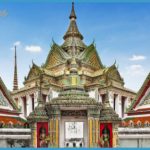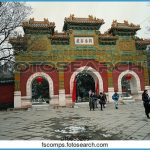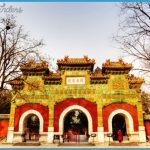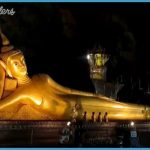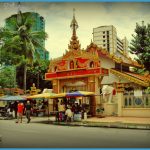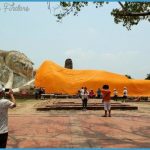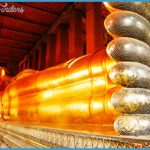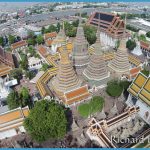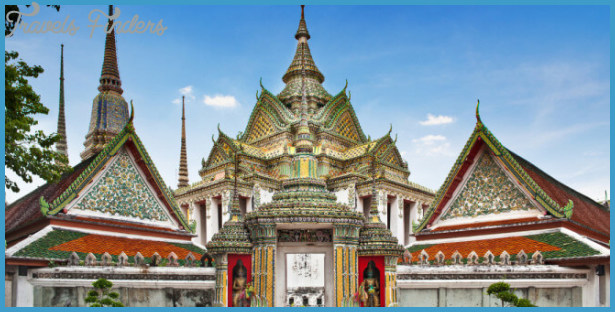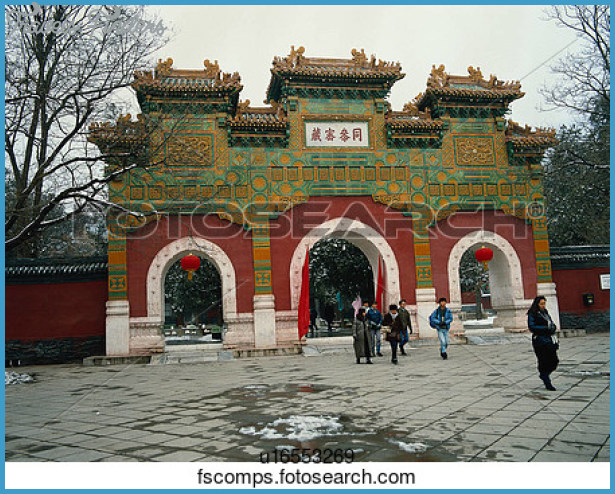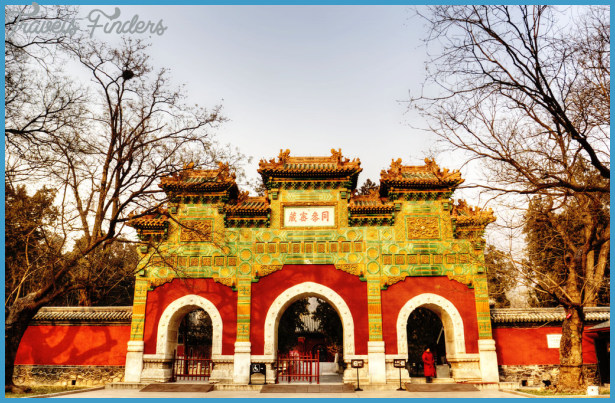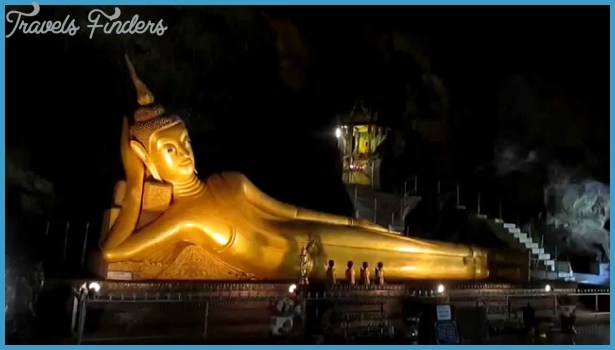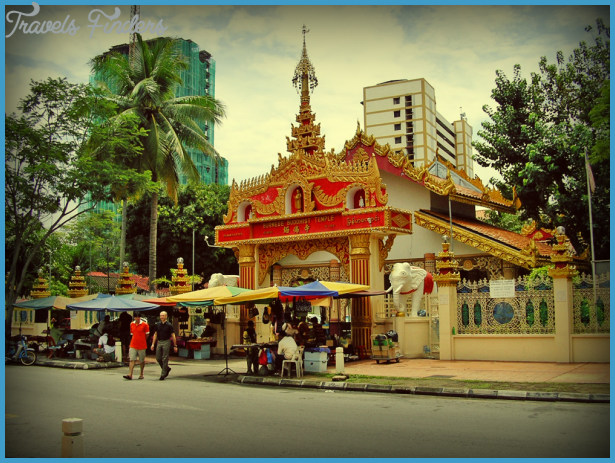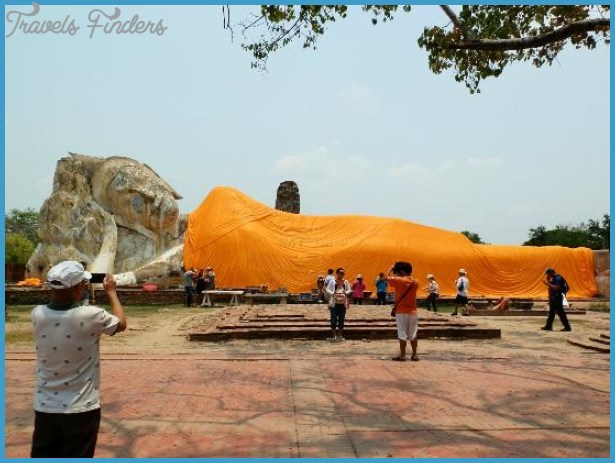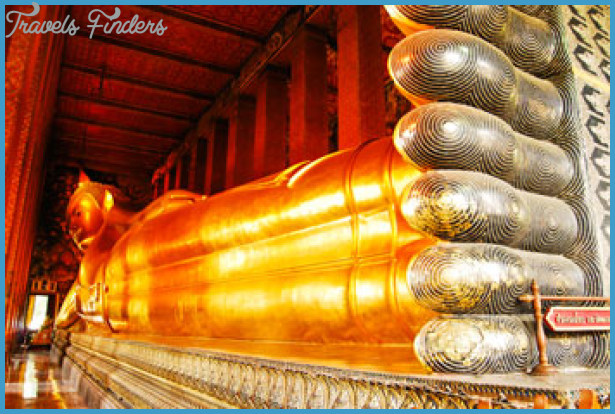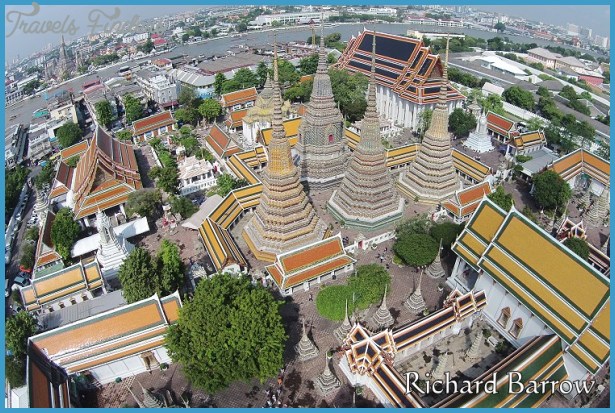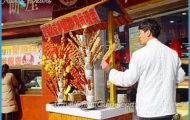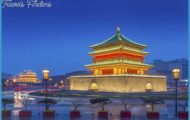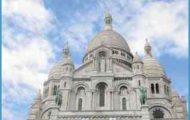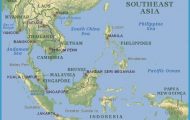The following main hall belonging to the temple complex is the Sun-Yat-sen Memorial Hall. The body of Sun-Yat-sen (See Famous People) was laid in state here in 1925, the hall is now dedicated to memory ofthe “Father of the Republic”. Kept here are busts ofthe politician and his silver-plated coffin, a gift from the Soviet Union, although it did not reach here until two weeks afterthe burial. In the side rooms is an exhibition with photographs about the life and work of Sun-Yat-sen,
In the nearby Spring Courtyard (Shuiquan Yuan), visitors may rest and enjoy the scenery.
Behind the Memorial Hall the 35m/114ft high Diamond Throne Pagoda rises up in the middle of a two part terrace. It is surrounded by four smaller pagodas and two dagobas. Its name is reminiscent of the town Bodh Gaya, where Siddharta Gautama gained inspiration. Here the body of Sun-Yat-sen was laid in state until it was transported to Nanking in 1929. The pagoda still contains his hat and some of his clothing.
The Temple of the Sleeping Buddha (situated to the north-east of the Fragrant Mountain on the Shouanshan Mountain), dates back to the first half of the 7th c. it was enlarged between 1320 and 1331. From 1734 the temple was officially named Temple of Universal Spiritual Awakening (Shifangqujue Si) although it is unofficially named after the great bronze statue of the sleeping Buddha. When visiting this temple the first things to be seen are an 18th c. decorated gate, then a small pool, the bell tower on the left, and the drum tower on the right. To be seen on the second floor of
the Hall ofthe Kings of Heaven (Tianwang Dian) are statues of Maitreya and the four Kings of Heaven. In the third courtyard is the Hall of the Three Saints (Sansheng Dian), where a Shakyamuni statue and eighteen Luohan figures are kept. The Wofo Dian houses the figure of the sleeping Buddha on his way to Nirvana. The statue is surrounded by twelve statues of his pupils. The monumental sculpture, 5.33m/17ft long and weighing 53 tons was created by 7000 craftsmen in 1321.
These gardens, situated less than a mile to the north-west of the Temple of the Sleeping Buddha, are popular with day visitors. There is a beautiful view from the hill called the Cloud Peak Half-way to Heaven (Bantian Yunlin).
The Badachu comprising eight temples is Situated on the Cuiweishan and Lushishan mountains to the south ofthe Xishan range.
The Temple of Eternal Peace on the Cuiweishan was erected in 1504. In the first hall is a bronze statue of Guan Yu who was a general at the time ofthe three empires (220-280); the second hall is dedicated to Shakyamuni.
A further hall is dedicated to the Goddess Niangniang who is believed to fulfil the wish for children.
Tothe north ofthe Chang’sn Si istheTempleof Godly Light. Like the nearby octagonal Liaota pagoda (1071), this temple was also destroyed by foreign troops in 1900. According to historical records, one of Buddha’s teeth was supposed to have been stored here (one of the four teeth brought to China from India after his cremation). While clearance work was being carried out following the temple’s destruction, a wooden box was discovered containing the tooth. This was taken to the Guanji Si temple for some time until a new home was found for it here in the 1950s in the Buddha-tooth Pagoda (Foya Ta).
Further to the north, between the Cuiweishan, Lishishan and the Ping-boshan mountains, is the little Monastery of the Three Mountains, the origins of which are unknown. There is a fine view from the pavilion in the temple grounds.
Next is the Temple of Great Compassion dating from 1550. Particularly worth seeing are the eighteen Luohan figures, attributed to the famous sculptor Liu Yuan.
Following on to the north-west is the Hall of the Dragon King where, according to legend, the “dragon king” lived. The building, also called The Monastery of the Dragon Spring (Longuan An) datesfrom the Qing dynasty (1644-1911).
The next and largest of the eight temples is the Temple of the Fragrant World originating from the Tang period (618-907) when it was called Pingpo Si. It was modernised in 1678 by Emperor Kangxi, and again in 1748 by Emperor Qianlong. At that time an imperial residence and a library for Buddhist manuscripts were founded here. In the main hall, which isflanked by the bell and drum towers, can be seen statues of Buddhas past, present and future.
The monk Haiyou supposedly lived for forty years during the Qing dynasty (1644-1911) in this cave on the peak of Cuiweishan; its name is taken from the pearl-shaped stones at the entrance to the cave.
The Temple ofthe Cult of Buddha, dating from the Tang period (618-907), is situated on the mountain opposite; Lushishan. It was later renovated several times. In the first courtyard is a 2m/6ft high bronze bell from 1470. In the north of the site is the Mimo Yan rock which is shaped like a lion’s

